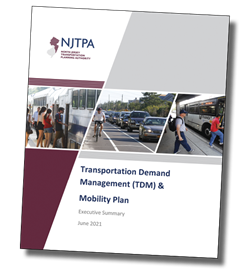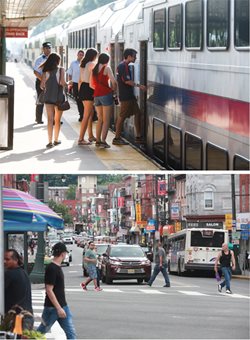 The NJTPA has released a Transportation Demand Management (TDM) and Mobility Plan that identifies regional policies and strategies to increase traveler choices while also minimizing the negative impacts of single-occupant vehicle (SOV) travel on congestion, air quality, and safety.
The NJTPA has released a Transportation Demand Management (TDM) and Mobility Plan that identifies regional policies and strategies to increase traveler choices while also minimizing the negative impacts of single-occupant vehicle (SOV) travel on congestion, air quality, and safety.
The plan and its recommendations helped inform policies in NJTPA’s updated long range transportation plan, Plan 2050: Transportation, People, Opportunity.
Prior to the COVID-19 pandemic over 2.2 million or 69 percent of the region’s residents drove to work alone, making SOVs the most common commute mode choice, according to the TDM plan. Transit was the second most common commute mode choice with nearly 500,000 riders (13 percent of commuters).
Reducing reliance on SOVs would make the transportation system operate more efficiently, provide more options for people who cannot or choose not to drive, and reduce the climate impacts of driving. Regionally, according to the research for the TDM plan, congestion adds an average of 17 seconds per mile to auto trips.
 TDM encompasses a host of strategies and programs, including: monetary incentives; carsharing or bike sharing; dedicated bus lanes; protected bike lanes; reducing parking requirements; working with employers to host carpools or vanpools or provide incentives to take transit; public transit improvements, such as accurate real-time arrival information, reduced fares for some trips, and easy to use wayfinding; and marketing the benefits of reducing driving.
TDM encompasses a host of strategies and programs, including: monetary incentives; carsharing or bike sharing; dedicated bus lanes; protected bike lanes; reducing parking requirements; working with employers to host carpools or vanpools or provide incentives to take transit; public transit improvements, such as accurate real-time arrival information, reduced fares for some trips, and easy to use wayfinding; and marketing the benefits of reducing driving.
The NJTPA has supported these and other strategies, particularly through its work with the state’s eight transportation management associations. Preparation of the TDM plan included investigation of over 50 strategies, including those that are demand-focused (reducing the demand for drive-alone trips) as well as supply-focused (increasing the supply of sustainable alternatives to driving). These were narrowed to the following six high priority strategies with input from NJTPA subregions and regional stakeholders:
- Institutionalize a complete streets approach to designing, building, and maintaining roads, which has the potential to increase the convenience and safety of walking and biking, thereby reducing the need for vehicle trips.
- Help municipalities integrate sustainable and equitable transportation initiatives into land use and development decisions.
- Support telework and teleservices, which reduce trips and can increase access to employment, healthcare, and social services.
- Create a “Mobility on Demand” platform to enhance traveler information, trip planning, and payments across multiple services.
- Fund first/last mile solutions including transit shuttles, car services, micromobility systems, and bicycle/pedestrian networks connecting people from home to transit or from their transit stop to their workplace or destination.
- Enhance NJRideshare.com, New Jersey’s carpool and vanpool matching system to better meet the needs of commuters and non-commuters alike.
The plan provides implementation guidance for each of the six selected strategies. The TDM plan is on the NJTPA website.